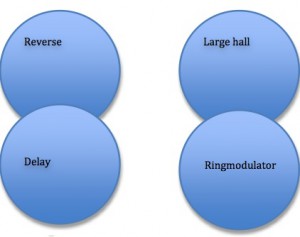I will not go into the technical aspects of the project, but I will focus mainly on the usability, musical process, experiences and observations. A further description of the Stagetracker FX can be found at www.tta-sound.com. To put it simply: by wearing sensors and moving with wireless microphones, the system was able to detect each singer and send the signal from each singer to different effects, depending on where the singer was moving. The system was also able to give an audible illusion of the singer’s placement in the room (left/right, front/back). This last function was somewhat limited when working in a small room with only 5 loudspeakers, but it was more precise in the concert hall where we had 12 of them.
Setup at Lindemanssalen, the Norwegian Acadamy of Music, NIME 2011
The project was developed during two sessions:
Part 1: 2 days in Trondheim: setting up the system for four singers in a theatre studio room, testing functionality, effects and strategies. Discovering some technical problems, and solving them.
Part 2: 3 days of rehearsals and performance at the National Academy of Music (NMH), Oslo. The performance was a part of the NIME (New Interfaces for Musical Expression) 2011 conference . We worked for 2 days in the rehearsal room, and on the last day we were rehearsing and performing in the Lindemanssalen Concert Hall at the NMH.
Asle Karstad and John Torger Skjelstad, Day 1 in Trondheim
First session in Trondheim:
The room was ‟divided” into 4 different ‟sound zones”, each with a specific effect assigned to it. Each zone had the form of a circle, where the effect was strongest in the centre, but gradually becoming weaker as we moved outwards. Some of the zones were set up to be ‟cross-fading”; as we stepped gradually out of one zone, we entered another, so that in a specific area we had a small amount of two effects at the same time. To start with we worked with the effects of delay, large hall, short reverse and ring modulator.
Sound zones and overlapping, simple illustration 1:
Experiences and observations, first session:
It is actually working! There was a great deal of enthusiasm in the ensemble; the sensation of sound transformation happening by simply moving in the room was inspiring. We worked with improvisations: 3 singers moving individually, and one listener/observer. We also tried moving the group of singers collectively from zone to zone. This was done in two ways: both when working with a collective musical idea that was transformed simply by the change of effects, and also by gradually changing the musical idea as a response to how the effects changed (improvising “with” or ‟on” the effect).
The most dramatically difference with this setting compared to our normal concert setup, was the new sounds that we could freely choose to work with by simply moving on stage. Watching and listening, we also observed that the movements in the groups, motivated by the will to enter a sound zone, created an improvised choreography that had a special quality. We also realised that it was even more important to focus on being disciplined and listening ‟outwards” in the free improvisation when we had all these new possibilities of sound.
These experiences were important for the further planning of the project. I wanted to have a ‟neutral” zone with a more natural/neutral reverb in the centre of the stage, and I wanted to have both the possibility of cross-fading zones and going in and out of a zone without cross-fading. A neutral zone surrounded by overlapping zones in a half-circle would allow this, so this was an ideal plan for a setting. (This exact wish subsequently turned out to be difficult, and I will return to this later.)
It was also possible to plan a way for arranging/choreographing a previously rehearsed composition based on this setup.
Second session, Oslo, working methods
The rehearsals in Oslo were held in a rather small room for the two first days, but we managed to create an ‟almost neutral zone” for working with the change from neutral to effect. The working methods we used were similar to those we had employed during the first session, but we started with a demo from the singers that had been working in Trondheim. We worked with both improvised and more structured group movements. First and foremost there was a need to focus on and rehearse the connection between input and output in the different zones. The different characters of the effects were tried out and discussed. We also changed from the ring modulator to a slicer effect when there was no direct voice signal coming out, only the processed sound. ‟Fading” in and out of, and ‟cross fading” between the zones were tried out. We also used techniques that we had been using earlier, introduced to us in a commissioned piece by Mats Gustafson[1] in 2009. In this piece the composer is also the director of the ensemble, with gestures for different musical cues within partly improvised, partly defined material. These techniques can easily be used within groups of the ensemble as part of a free improvisation; each singer can take the initiative to become the director of the rest of the group. Our work with the zones created different groups at different times, gathered in the same zone, so this was a very natural possibility. We also created a setup and ‟choreography” for a composition [2]. The spatial placement of the effects was changed accordingly and we rehearsed a shift from a setting for improvisation into a setting for this composition.
[1] Mats Gustafson: Swedish free jazz saxophone player and composer, see http://matsgus.com/
[2] “Slipp” by Ståle Storløkken, commissioned for BINGO!! 2008



